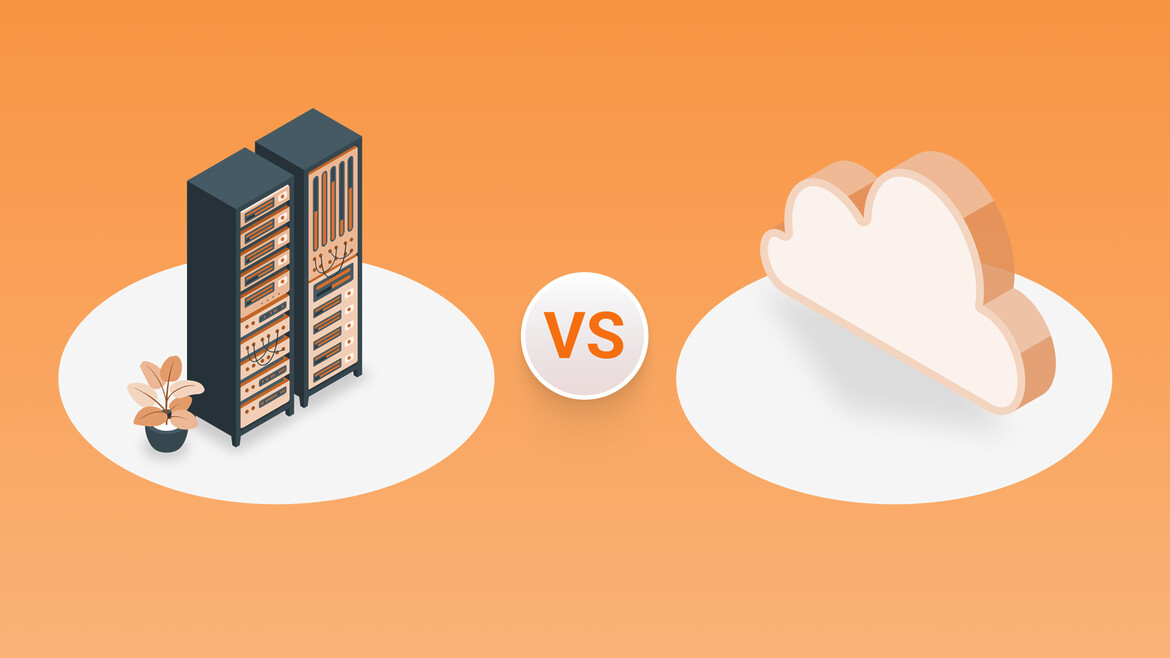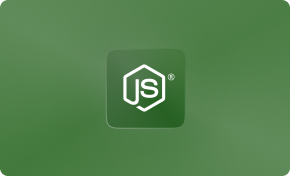Cloud computing is almost ubiquitous now, with more than 96% of all companies utilizing some public cloud services. Global spending on cloud services is expected to increase to $723.4 billion in 2025, compared to $595.7 billion in 2024. However, on-premises data centers have not become obsolete. Cloud services currently comprise a significant portion of overall IT spending, with some estimates suggesting that they account for ~15%.
Many organizations, however, still rely on in-house infrastructure to support critical systems. The cloud vs. on-premise decision is particularly significant in regulated and data-sensitive industries such as fintech, healthcare, insurance, transportation, and logistics.
Begin Your Digital Transformation Journey
Customized Strategies to Lead Your Business into the Digital Age
Explore Digital TransformationA decade after the cloud-first strategy period, according to IT decision-makers in 2025, the approach is becoming more complex. There is doubt among many about the extent to which the public cloud is suitable and affordable for all workloads.
Large-scale public examples of so-called cloud repatriation, such as companies moving their workloads back on-premises, point out that there is no one-size-fits-all in cloud computing. For example, companies such as Dropbox and 37signals (Basecamp) withdrew essential services from the public cloud, citing significant savings as the reason. It is reported that 21% of enterprise cloud expenditure (approximately $44.5 billion) is wasted due to the use of underutilized resources, which is a clear indication that cloud costs could easily run out of control without proper management.
Meanwhile, hybrid cloud approaches are gaining popularity, where cloud and on-premises environments are combined to create a trade-off between flexibility and control. Cloud or on-premise has become a crucial strategic decision that impacts cost control, performance, security, regulatory compliance, scalability, and business continuity.
Here, in this thought leadership guide, we evaluate cloud versus on-premise infrastructure based on the following areas: cloud vs. on-premise infrastructure in fintech, health care, insurtech, transportation, and logistics. We also provide a comprehensive decision framework to help IT leaders make informed infrastructure choices in 2025 and beyond.
Cloud vs. On-Premise: Defining the Difference
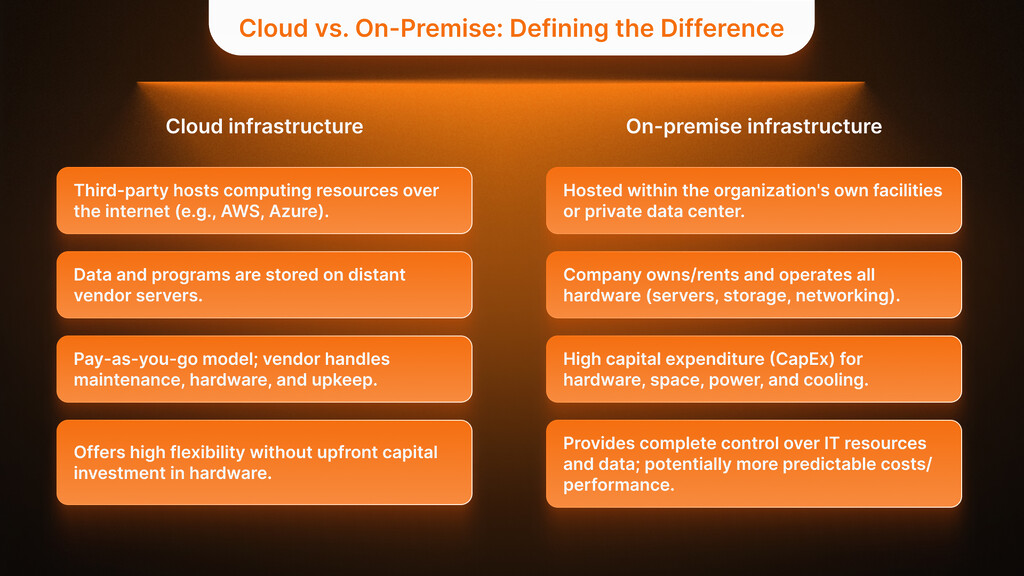
Cloud infrastructure is computing resources offered as a service on the internet by a third party (public cloud offerings by vendors, such as AWS, Azure, or Google Cloud, or private clouds). Information and programs are stored on distant servers in vendor-based data centers as opposed to being located on the company itself.
Customers usually only pay what they use, and the cloud provider does the maintenance, hardware, and upkeep. The model offers high flexibility without requiring companies to invest capital in hardware such as servers, storage, databases, etc., in advance.
On-premise infrastructure, alternatively, is hosted inside the facilities of an organization or in a private data center. It is the company that owns or rents the servers, storage, and networking equipment and operates them using its IT personnel. Using on-site hosting of data and systems, a business maintains direct physical access to infrastructure and lowers its dependence on third parties.
On-prem environments are costly in terms of capital expenditure (CapEx), hardware, data centre space, power, and cooling, but allow organisations complete control over their IT resources and data. The model is flexible to tailor it to a given need, and it might be more predictable in some costs and performance attributes.
It is necessary to mention that cloud and on-premises solutions are not mutually exclusive, and many enterprises implement a hybrid solution that incorporates both. By way of example, a single company may store sensitive customer information or legacy systems in-house, and in the cloud store the customer-facing applications or websites. Indeed, now more than 56% of large businesses (with revenue exceeding $500M) declare the use of a hybrid cloud strategy.
The aim is to take advantage of the best of both worlds: scalability and innovation in the cloud, as well as control and reliability of on-prem. Putting these definitions aside, how can we compare cloud and on-premise on the dimensions of the major decisions?
For an in-depth comparison of distributed vs. centralized IT strategies, explore Edge Computing vs. Cloud Computing.
Cost Considerations: CapEx vs. OpEx and Total Cost of Ownership (TCO)
A cost model is one of the most considerable disparities between cloud and on-premise infrastructure. Cloud services also shift IT expenditure to an operating cost model, replacing capital costs with monthly or per-use charges for computing, storage, and bandwidth. It will be a pay-as-you-go system, which translates into a cheap up-front cost and a simple view of cost in the early days.
It is particularly attractive to startups or those projects where you do not want to spend a lot on hardware. It is also possible to optimize costs on variable or unpredictable workloads; you may add or remove resources to match demand, reducing the chances of wasting and over-provisioning.
Nevertheless, cloud expenditures may accumulate and even surpass on-premises costs in the long term if not carefully regulated. Usage-based variable pricing can result in unexpected bills; in reality, 6 out of 10 organizations report that their cloud bills were higher than planned.
The biggest challenge that cloud decision-makers face is managing cloud spend. An example of cost overruns is the need to pay data egress fees, provide duplicate services, and deal with orphaned resources. According to a recent analysis, it is estimated that 21% of enterprise cloud investments are wasted on idle or underutilized resources; therefore, diligent cost optimization (FinOps) is necessary. Cloud providers offer their tools for monitoring and minimizing costs, and it is up to each company to make them effective.
On-premise infrastructure, in turn, involves high initial expenses (purchasing servers, storage solutions, networking devices, software, etc.), as well as ongoing expenditures on power, cooling, space, and IT support. This CapEx investment may be sizable – the development of an exclusive data center or even a server room requires a substantial budgetary investment.
The benefit is that on-premises hardware, after being purchased, can be used over a couple of years, and the prices are definite and unchanging, rather than fluctuating. Assuming that the workloads of a company are relatively constant and predictable, the total cost of ownership of an on-premises solution can be lower in the long term.
For example, when you require a steady supply of compute and storage, you have an ongoing level of compute and storage needs, and the costs of using the cloud provider’s services are more affordable than the costs of purchasing your own infrastructure. The examples of companies that save money by bringing workloads back are real-life: one company saved the cost of an annual infrastructure of $3.2 million (cloud) to $720,000 (on-premises) with an initial hardware investment of $ 600,000.
With that said, on-prem costs are not immune to changes either; hardware must be upgraded, and the inflation of resources can create underutilization of capital in the name of being prepared. Also, on-prem shops require skilled personnel to perform maintenance and troubleshooting, which is a cost by itself. Cloud costs are operational expenditure (OpEx), which are scaled to use compared to on-prem, where much of the costs are capital expenditure (CapEx) and depreciated over time.
The complete TCO analysis must include the hardware lifecycle, support contract, software licensing, and staffing for an on-premises solution, compared to the all-inclusive cloud service costs (which include these). Granular cost comparison is being carried out by many organizations. The point is that cloud is less expensive in bursty, short-term, or explosively scaling use cases, but on-premises might be less costly in steady-state scaling.
IT leaders need to consider CapEx vs. OpEx preferences, flexibility of budget, and the threat of unexpected costs. Hybrid in practice can also minimize costs, e.g., running on its own hardware at baseline loads and bursting to the cloud during spikes.
Experience the Power of Custom Software Development
Transformative Software Solutions for Your Business Needs
Explore Custom SoftwareLearn how proper project management can reduce costs in How to Prevent and Manage Scope Creep in Software Development Projects.
Performance and Latency
Where your infrastructure lives is an essential factor in performance; on-premise infrastructure can typically offer predictable, low-latency application performance when applications are utilized on or near the organization’s premises. Latency may be measured in microseconds to milliseconds, and the performance is very predictable because servers and end-users (or other systems) may share the same local network.
Organizations can tune on-prem hardware to a particular workload (with high-end CPUs, GPUs, or faster storage as required) and do not share resources with third parties. Overall, on-premises deployments can be used to support local user response times more rapidly, and with greater performance predictability, as you own the end-to-end environment.
Performance under cloud architecture is more sensitive to network connectivity and cloud architecture. The applications run on the internet (or on dedicated telecom links to the cloud); therefore, latency and throughput are subject to network latency and bandwidth constraints. Cloud data centers are high-performance environments in themselves, with top providers investing in leading-edge hardware and providing features such as low-latency global load balancing.
However, the multi-tenancy of resource sharing and the distance to the resource can introduce variability. Consequently, it can be associated with reduced predictability of performance, particularly of latency-sensitive workloads, since you are at the mercy of the cloud network conditions. For example, an algorithmic trading application in fintech would encounter excessive latency when required to connect to a remote cloud region; some financial companies continue to house servers co-located with stock exchanges to achieve sub-millisecond latency. Similarly, a manufacturing factory floor system may require a real-time response, which is best suited to on-premises or edge computing.
With this in mind, cloud providers offer measures to address such concerns. You have the option to select geographical locations that are physically close to your user base, implement content delivery networks (CDNs) with data cached closer to end-users, or even edge computing nodes. In the case of wider global use, being distributed is a huge benefit to the cloud, as it allows workloads to be located in different data centers across various continents, thereby bringing them closer to customers, which most companies cannot do themselves.
Cloud also allows access to specialized high-performance (GPUs, FPGAs, high-memory instances) resources on demand, which may not be practical to own in-house. Clouds such as the large clouds will have SLAs (Service Level Agreements), which are usually high uptime and good performance (usually 99.9% availability or higher), but not absolute latency or throughput.
In short, on-premises solutions are best suited for low-latency, high-throughput workloads on the local network, while cloud solutions perform best when providing distributed users with performance at scale. In case of heavy internal data processing in your workloads (e.g., an analytics database that crunches data 100% internally), then on-prem may provide faster results in your LAN.
Experience Our Skilled Development Teams
Elevate Your Projects with Skilled Software Development Professionals
Get Your Development TeamIn some cases, the cloud can even enhance perceived performance: users worldwide, connected to many external services, have their workloads optimized through the network and PoPs (points of presence). A combination of on-premises or edge latency-critical applications and cloud-hosted, lower-latency or global-service applications is adopted by many organizations.
Explore performance-enhancing tools in The Ultimate Guide to Mobile App Security and Performance.
Security Considerations
Security has been mentioned as both a contributor to and an issue with cloud computing. With a cloud model, security is shared; the customer is responsible for securing their applications, data, user access, and configuration. In contrast, the provider ensures they secure the underlying infrastructure (physical data centers, hardware, and base software).
Major cloud providers invest a significant amount of resources in security, offering encryption, network firewalls, DDoS protection, continuous monitoring, and regular patching. Most organizations claim enhanced security when they shift to the cloud. In a survey, 94% of businesses reported that their security levels improved after adopting the cloud. This is usually the case, as they leverage the sophisticated security solutions that providers employ and the expertise of professional cloud security teams, which small IT departments cannot easily replicate.
But with outsourcing infrastructure, there is also less control. The companies must have confidence that the cloud vendor effectively isolates tenants and safeguards against breaches. Improper settings in the cloud environment are one of the primary causes of incidents, such as failing to set the storage bucket to private. In fact, 68% of cloud security breaches are attributed to misconfiguration.
The most notable data breaches have happened because businesses did not encrypt their cloud servers or APIs. Moreover, a large number of companies use the same large providers, so the outage or security breach of one cloud service can affect many organizations simultaneously in a so-called blast radius. This interdependence represents a distinct type of risk compared to the isolated nature of on-premises systems.
Security is entirely within the organization’s hands in the case of on-premise infrastructure, and this is both an advantage and a disadvantage. On the positive aspect, you can control all the security policies, network segmentation, and physical access completely. Data does not leave your premises (you decide to post it somewhere), automatically minimizing external exposure.
Organizations can deploy their security architectures that are optimized specifically to their threat model. Even some very sensitive organizations will use an air-gapped network or stringent internal access controls that would be difficult to enforce in a public cloud. Classified government systems, some core banking systems, or other situations where complete control and isolation are a requirement are often deployed on-premises.
The negative aspect is that high security on-premises is expensive in terms of the resources and expertise required to maintain it. You must maintain firewalls and intrusion detection systems, antivirus software, and keep software updates current, as well as manage user privileges, among other tasks, without the automatic updates that cloud services often provide. Smaller organizations may find it hard to maintain up-to-date security practices on-premises.
A financially capable cloud provider may also be able to offer stronger baseline security (consider the amount of investment other companies, such as Google or Microsoft, are making in cybersecurity). In fact, 91% of organizations report that cloud usage has helped them comply with government regulations and audits, indicating that cloud platforms can support a security compliance strategy through pre-certified infrastructure and security services.
Both models are, in practice, capable of being rendered secure, but in different ways. Cloud security requires active configuration management, cloud-native security tools (used to observe and identify threats in cloud computing environments), and close identity and access management (IAM) so that only authorized users and systems can access data. On-premises security requires adequate perimeter security, network security within an organization, and physical security (e.g., securing server rooms) – as well as the discipline to apply patches and updates on time.
To many, a hybrid path is beginning to make more sense: maintain the most sensitive data or workloads in an on-premises, highly controlled environment, but utilize the cloud for less sensitive workloads, all under an integrated security policy (usually following the principles of zero-trust, regardless of where the workload runs). Its secret is knowing your tolerance for risk and regulatory requirements, and that brings me to the next point, which is compliance.
Compliance and Regulatory Requirements
Strict regulations governing data handling, privacy, and reporting apply in industries such as finance, healthcare, insurance, and government. Compliance is a common issue that determines the choice between cloud vs. on-prem. One of the biggest questions is: where the data is kept and who can control or access it. In certain jurisdictions, the law of data sovereignty states that specific data (such as financial records or patient data) must reside in a given jurisdiction.
In this scenario, it may be challenging to utilize a public cloud when there is no local region available for data transfer, storage, or access outside the country. Other institutions have a legal obligation to store data on-premises to meet the sovereignty or privacy regulations. For example, a European healthcare provider that processes EU patient data under the GDPR may prefer an in-country private data center if they are not comfortable with the availability of cloud regions or data flows across borders.
Cloud providers have responded by offering region-specific services and compliance guarantees. Nowadays, every central cloud has several geographic regions, and most of them can specify that the data should remain in a particular country or area. Providers also obtain certifications such as ISO 27001, SOC 2, PCI-DSS, HIPAA, and others to demonstrate compliance controls. Indeed, most businesses believe that it is easier to be compliant with the help of leading cloud platforms, with 91% agreeing that cloud made it easier to meet government compliance obligations.
For example, healthcare organizations may utilize services certified as HIPAA-compliant and enter into Business Associate Agreements (BAAs) to process protected health information, provided that they configure and use the services in a HIPAA-compliant manner. Cloud services are available that are PCI-DSS compliant for storing payment data or customized to meet banking regulations. Several banking regulators have issued guidance on cloud-based banking, focusing on risk management and due diligence, but not necessarily banning its use.
Nevertheless, the on-premise infrastructure provides a satisfying feeling in terms of compliance. When systems are on-premises, companies with very rigid internal policies or custom regulatory requirements may directly implement those restrictions themselves. They will be able to ensure that nothing leaves the premises without their intention and can design audit and logging systems to specification.
For example, an insurance corporation might retain an on-premises database of its customers’ personally identifiable information to comply with privacy regulations, while performing cloud analytics on the de-identified data. On-prem also does not have the complexity of vendor compliance documentation; internal compliance teams can directly perform inspections and test the available controls.
A possible drawback is that the compliance process, including its achievement and maintenance, is entirely your responsibility – you will need to allocate resources to audits, certifications, and control updates in the event of changes to the regulations. Cloud vendors frequently revise their compliance mappings and commonly offer tools (such as encryption key administration, audit logs, and automated inspection of conformity) that may lighten the load. However, where a rule is so tight that a third party cannot be trusted (e.g., some defense contracts), on-premises or air-gapped systems are a non-starter.
Overall, align your infrastructure decision with your compliance requirements. If your business requires absolute data residency or specific control frameworks that cannot be satisfied in the cloud, an on-premises or private cloud will likely be a safer option. When employing cloud, select providers and configurations that support your certifications (and be ready to show auditors).
A hybrid approach to compliance is popular: the highly regulated data stays on-prem, but the workloads that can be compliant in a public cloud can be migrated there (with appropriate encryption and access controls). Such a mixed strategy can give satisfaction to the regulators and enable the business to innovate with the help of cloud services.
For healthcare-specific guidance, read Customer Portals & Mobile Apps: Driving Growth for DTC Health Brands.
Scalability and Flexibility
Scalability on demand is one of the most significant selling points of the cloud. In a cloud environment, it is typically possible to add additional servers, storage, or processing capabilities with a few clicks or automatically, depending on the load. This elasticity enables them to manage traffic bursts or rapid expansion without needing to purchase additional hardware.
Actually, 62% of the IT executives who intend to move more workloads to the cloud are doing so to achieve more flexibility and scalability. When your fintech mobile application experiences an overnight surge in users, cloud infrastructure can deploy new server instances and database capacity in minutes to scale out and meet the demand. This nimbleness also applies to launching new environments for development or testing: teams can set up temporary servers and destroy them when they are finished, and only pay for what they use.
Tailored Mobile Solutions for Your Unique Needs
Redefine Your Business with Mobile Application Development
Explore Mobile App DevelopmentScalability is stricter with on-premise infrastructure. You must have the physical resources (free CPU, memory, disk) ready in your data center, or you must order and install new hardware. Such a process may require weeks or months of lead time in budgeting, purchasing, delivery, and installation. Hence, on-premises environments must be frequently constructed with headroom, or idle space, to future-proof them or support peak loads.
This can cause wastage of resources during regular periods (servers just lying idle). In cases where there is a high demand that exceeds expectations and your on-premises capacity cannot handle the demand, users may experience slowdowns and outages until you can increase resources. All this trade-off is well presented in the comparative analysis conducted by Intersog: cloud scaling is immediate and scalable, on-premises scaling needs planning and physical deployment.
To ensure predictability, it is possible to plan and scale on-prem in a step-wise manner (e.g., buy a new server rack per year). However, when workloads are random or extremely seasonal, cloud auto-scaling up and down can be highly beneficial. It does not just deal with peaks, but also allows you to scale back during lulls to save costs, something that your on-premises solution cannot do easily (purchased and unused hardware still incurs costs).
Flexibility also means rapid adoption of new technologies: do you want to play with a new machine learning service or a new database technology? Those services are on demand in the cloud. You may need to install special hardware (such as GPUs) or software licenses on-premises, which can hinder experimentation with new technologies, ultimately stifling innovation.
With that said, many on-premises environments can enjoy the benefits of cloud-like scalability in the form of automation and privately deployed cloud software (such as VMware or OpenStack). This may allow quicker provisioning within a company, but it can hardly compare to the sheer scale of a hyperscale public cloud. Additionally, when you scale out on-premises, you are likely to scale out your IT team as well to handle the increased workload.
In short, the cloud offers unmatched elasticity and flexibility, making it ideal for businesses that anticipate rapid growth or highly fluctuating demand. It enables you to be fleet of foot – to introduce new products, move into new markets without hardware lag. On-prem might be enough (and cost-effective) when the workload is stable and the capacity is clear and unlikely to increase suddenly.
The vast majority of large enterprises utilize both steady-state on-premises infrastructure as the basis and cloud burst capacity to handle fluctuations. In fact, one of the driving factors behind the popularity of the hybrid cloud deployments is flexibility, ~70% of IT leaders say a strong hybrid cloud strategy is critical to effective digital transformation. The freedom to select the best environment (cloud or on-premises) to run each workload enables organizations to optimize their operations to meet changing needs, both in terms of performance and cost.
See how scalable backends support mobile-first apps in How Mobile Apps Drive Business Growth and Engagement.
Business Continuity and Disaster Recovery
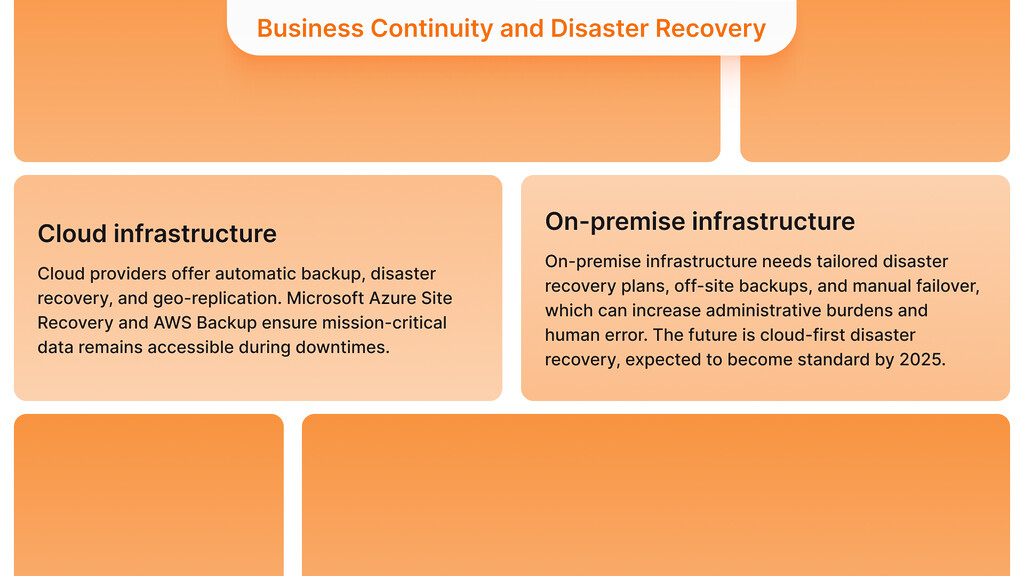
Cloud providers offer automatic backup, disaster recovery, and geo-replication services. Microsoft Azure Site Recovery and AWS Backup services ensure that mission-critical data is strong and can be accessed during downtimes.
On-premise infrastructure demands special disaster recovery plans, off-site backups, and manual failover procedures. Although it provides control, it also introduces an administrative burden and increases the likelihood of human error. The next big thing is cloud-first disaster recovery, which is expected to become a baseline expectation by 2025.
Business continuity
The ability to maintain operations during and after disruptive incidents is a crucial factor for IT infrastructure. This refers to readiness against hardware failures, data loss, outages, or natural calamities. In this case, cloud and on-premise have various advantages and difficulties.
The most popular cloud providers build their platforms to be highly available and resilient. They provide several availability zones (separate data centers) in various regions and geographic locations around the globe. Applications can be designed to operate across two or more zones, with the effect that in case one data center experiences a problem, traffic is diverted to the other.
Redundancy is built into many cloud services; for example, cloud storage services typically maintain multiple copies of your data in different facilities at no extra cost. The providers also integrate backup and disaster recovery (DR) tools, allowing you to back up servers or databases in the form of a snapshot and replicate it to another region with minimal effort.
This facilitates the installation of sound DR plans without the need to construct a second site. As observed, cloud SLAs typically offer an uptime of 99.9% or higher, in some cases even more. Naturally, outages still occur (no provider is immune to them at 100%), but the size and redundancy that is possible in the cloud can mitigate single points of failure. For example, deploying an application across multiple regions can even protect against the entire area being unavailable, a feat that only the largest on-premises enterprises could afford to achieve on their own.
Achieving the same degree of continuity in an on-premises model is costly and complex. Organizations must have redundancy of their own, including clustering of servers, spares, and even a secondary data center at a different location in case of disaster situations. The classical DR typically involves replicating the infrastructure to a remote site (active/passive or active/active data centers) and copying the data between these two centers.
This can be quite expensive; in fact, you might end up paying to maintain a backup data center that remains idle until a disaster occurs. Small and medium-sized companies may not have a complete second location, which makes them more susceptible to the failure of their central location (due to a fire, flood, power failure, etc.).
Even among on-premises systems in one data center, on-premises systems require backup power (generators, UPS) and well-tested backup procedures (tape, disk, or cloud backup) to avoid data loss. It is possible to achieve cloud-like uptime on-premises (there are some industries, such as airlines and banking, where the acceptable uptime is close to zero), but it requires enterprise-level engineering and budgets. Most organizations find it challenging to achieve a cloud-like 99.9% availability using on-premises solutions only, as one comparison noted.
Disaster Recovery
Cloud also makes disaster recovery testing simple; you can test failovers or spin up disaster recovery environments on a whim. On-premises DR tests are usually invasive and executed only rarely due to their complexity. Nevertheless, it is also essential to consider the issue of failure scope: an on-premises failure may be isolated (affecting only your company), whereas a significant cloud failure can impact many at once.
That is why there is a multi-cloud or hybrid DR approach, where on-premises data is backed up to a cloud storage service, or an organization can spin out critical services to a secondary cloud provider in the event of an outage by the primary cloud provider. This resilience can be enhanced further with such diversification.
To the majority, the cloud offers simpler ways to achieve robust business continuity, particularly for those without secondary sites. An off-site backup or hot standby is sometimes a cost-effective insurance policy. In the meantime, on-prem should be planned carefully in terms of continuity as well, which you may do in case you cannot use cloud backups due to specific regulatory or security reasons.
In some industries (e.g., banking), there are documented recovery time objectives (RTOs) that can be achieved through either method. However, the cloud simplifies the process of attaining aggressive RTO/RPO objectives by leveraging its distributed infrastructure.
In practice, a hybrid BCDR (Business Continuity and Disaster Recovery) strategy is common in many organizations. A hospital, for instance, could host its central clinical systems locally but back up data continuously to the cloud, ensuring it remains available in the event of a local server failure.
Alternatively, a retailing firm can have e-commerce websites in the cloud (due to geo-redundancy) but maintain a local, read-only copy of the essential databases on-premises as a backup. The secret is to analyse the consequences of downtime and data loss to your business and then design a solution (cloud, on-premises, or hybrid) that fits those requirements within budget.
The cloud-first disaster recovery is the new expectation in 2025. Find out more about DR in Why Recovery Point Objective (RPO) Is Critical to Business Resilience.
Industry Insights: Fintech, Healthcare, Insurance, Transportation, and More
Each industry has unique drivers and constraints that influence the decision between cloud and on-premise solutions. Here we highlight insights for some key sectors:
Fintech & Financial Services
Particularly, financial institutions have adopted cloud practices slowly but steadily, sometimes through hybrid cloud strategies. Banks and fintech startups are being pulled and pushed towards the cloud and on-premises, respectively, due to the need for greater agility (digital banking, mobile apps, and services driven by AI), as well as high regulatory oversight and risk management of core systems.
It ends up being a hybrid blend; for example, most banks are currently implementing core banking systems in hybrid configurations, where sensitive customer transaction data is stored on the company’s infrastructure, and the cloud is used to scale the front-end, customer-facing services.
This commitment to hybridization was revealed in a 2024 Nutanix report, which forecasted a threefold increase in hybrid multi-cloud adoption by the financial industry within the next three years. The hybrid approach of on-premise and public cloud enables institutions to balance security and agility, ensuring data integrity and alignment with strict regulations, while also taking advantage of the cloud’s elasticity.
For example, cloud computing capabilities are increasingly being utilized in real-time payment processing systems and anti-fraud systems to manage the growing volumes, although on-premises fail-safes are also common. Financial regulators have begun to allow cloud use and have demanded that companies take control of vendor risk; thus, larger banks are investing in cloud governance and, in some cases, multi-cloud environments to prevent over-dependence on a single provider.
The emphasis on cost, control, and risk mitigation in financial services is evident in recent Citrix survey results, which found that 42% of U.S. organizations (many of which are in financial services) are at least considering returning at least half of their cloud workloads to on-premises environments.
In the future, there will likely be cloud-native fintechs that do not store highly sensitive data. Continuing to operate as a hybrid, modernizing legacy systems over time, and maintaining close control over highly valuable data will likely be the approach that traditional banks choose.
Healthcare & Life Sciences
The healthcare industry, including hospitals, clinics, and biotech companies, is undergoing a digital transformation where the cloud is gaining momentum. By 2023, 81% of healthcare executives say they have already started a cloud transformation (slightly higher than the cross-industry average of 78%).
The necessity to reduce IT expenses, enhance collaboration efficiency between providers, and utilize large amounts of data in research and AI are all drivers that the cloud can enable. As an example, genomic sequencing or training of medical AI models requires large data volumes and compute resources that are costly to maintain on-premises; transferring them to the cloud allows for essentially unlimited capacity and powerful analytics tools.
Telemedicine platforms and patient portals can also be built using cloud-based systems, as they must be available 24/7 and accessible from anywhere. With that said, adherence to such regulations as HIPAA (in the U.S.) is of paramount importance. The healthcare organizations need to make sure that any cloud service that deals with protected health information is HIPAA-compliant (many organizations use specialized healthcare cloud services or their private clouds to do so).
We observe a tendency when less sensitive workloads (e.g., appointment scheduling devices or public health websites) migrate to the cloud, while the most sensitive electronic health record (EHR) databases may be retained on-premises or in a private cloud.
Larger hospital networks with hybrid approaches may also store patient data in on-premises data centers to maintain privacy, while running cloud-based analytics on de-identified data to enhance care insights. Security also ranks high on the list of concerns lately. Healthcare has experienced an increase in cyberattacks, and providers are considering whether cloud security services can better secure their data or if they want to maintain control over their data on-premises.
Based on the trend, it is likely that the cloud will keep increasing in the healthcare sector (particularly as AI-based diagnostics and IoT remote monitoring gain traction), though the lens of compliance will always be present, where encryption is frequently done in strong form and backups are kept on-site as a form of fail-safe.
Insurance (InsurTech)
The insurance sector was previously cautious about cloud, but it has quickly closed the gap. Whereas just one-third of insurers had any presence in the cloud in 2020, in 2023, it is expected that 85-88% of insurance companies will use cloud services. This leap was driven by InsurTech startups and the need for incumbents to update their customer portals, mobile apps, and data analytics.
Insurers work with vast quantities of data (actuarial data, data fed to IoT sensors to run telematics (usage-based insurance), and so on), and on-prem systems could not easily keep up with these volume and scale requirements efficiently. Cloud platforms enable companies to have the elasticity to run complex risk models, utilize machine learning for fraud detection, and implement omnichannel customer engagement tools without the need for massive upfront investments in infrastructure.
Most insurance firms have become cloud-first in their application strategies. As an example, an insurance company may have its quote engine and customer portal in the cloud so that it can scale up and down easily during peak inquiry periods (e.g., during the occurrence of a natural disaster many claims occur), but retain an older policy administration system on a mainframe in the interim.
Insurance compliance is somewhat similar to banking: data safety and confidentiality are essential, but the leading cloud vendors have the required certifications to store sensitive personal and financial information, a driver of cloud in insurance.
The drivers of cloud adoption in insurance include time-to-market benefits for new products, batch claims processing, and the removal of costs and complexity associated with running on-premises infrastructure. Nevertheless, most insurers do not abandon all on-premises systems, as they retain some core record-keeping systems on premises to achieve redundancy.
In general, the industry’s opinion is that cloud adoption is no longer a choice, as it has become the new norm for competitive insurers to adopt a hybrid deployment, transitioning towards modern cloud applications and systems of record.
Transportation & Logistics
Shipping and logistics providers, airlines, and ride-sharing companies are also finding that the cloud offers them opportunities to enhance efficiency and visibility in their operations. Indeed, 2024 trends suggest that there will be a mass use of cloud-based solutions to manage logistics operations.
The current forecasts indicate that in five years, 86% of supply chain and logistics firms will have adopted cloud computing as a means of running their operations, compared to the 40% at present. The causes are obvious: cloud platforms enable real-time monitoring of shipments, dynamically optimize routes, and enhance cooperation along the supply chain (including shippers, carriers, warehouses, and customers).
For example, a transportation management system (TMS) based in the cloud can help a logistics provider organize thousands of deliveries, providing live tracking and analytics to all involved parties via a web portal. The cloud is beneficial to such a type of system since it can interconnect worldwide distributed participants, as well as scale it to handle seasonal traffic (such as holiday shopping).
IoT integration also plays its role; the trucks, containers, and warehouses with IoT sensors will have more data streams (location, temperature, traffic conditions). By transmitting this information to cloud computers, it is possible to use AI to forecast delays or to optimise routes.
Nevertheless, the transport industry also prioritizes reliability and is often required to operate in conditions with intermittent connectivity (e.g., ships at sea or in a remote logistics center). This has created a hybrid solution: critical control operations can be on-premises or at the network edge to provide resiliency.
For example, a port authority can keep cranes and inventory systems running even when the cloud connection is lost. In contrast, constant data synchronization occurs with the cloud when the connection is present. Moreover, other logistics companies may be privacy-sensitive regarding data sharing and may want to use proprietary routing algorithms or sensitive data in a private cloud and on-premises environment.
However, the pressure toward efficiency, particularly in the wake of recent global supply chain upheavals, is causing even logistics companies that have traditionally been less than enthusiastic about technology to use cloud as an element of their IT portfolio.
Fleet management systems, logistics marketplaces on the cloud, and analytics dashboards are becoming the norm. It is reasonable to anticipate that transportation and logistics will pursue a cloudward trend in customer-facing and analytical systems, complemented by on-premises and edge components to ensure operational continuity.
Other Industries
The same is the case in other places. In the manufacturing industry, Industry 4.0 involves plants networking to cloud analytics for predictive maintenance, while maintaining machine controls on-premises to ensure safety. In the retail setting, store systems may be local because they often provide point-of-sale functionality even when the network is unavailable. Still, e-commerce systems may be in the cloud as part of scaling to manage the volume of traffic.
Government and public sector agencies continue to have a significant presence on-premises due to security and classification needs. Still, government-specific cloud regions (e.g., GovCloud) are becoming increasingly popular for hosting workloads that do not require the same level of security. What we are seeing across many industries is a sophisticated, workload-by-workload comparison of cloud versus on-premises solutions, rather than a one-size-fits-all approach.
For industry-aligned backend strategy, refer to AI Integration for Business: Practical Steps to Implement and Scale.
Decision Checklist: Choosing Between Cloud and On-Prem
The selection of the appropriate infrastructure model is a strategic choice that must consider several issues related to your organization’s requirements. The following is a checklist of the significant factors to consider when choosing cloud, on-premise, or some combination:
Regulatory Compliance & Data Residency
Find laws and regulations that may control your data. When you work with sensitive financial, health, or personal data that requires adherence to specific country regulations or controls, it may necessitate on-premises infrastructure or a cloud provider with a local presence and strict compliance assurances. For example, a bank that must comply with data sovereignty regulations may store customer databases on-premises or in a private cloud, but use a public cloud to host less sensitive middleware.
Cost Model and Budgeting
Think about your financial preference: are you CapEx (asset ownership) or OpEx (pay-as-you-go)? The OpEx approach in the Cloud is more agile and will result in unpredictable costs unless usage is managed (60%+ of firms received unexpectedly high cloud bills). On-premises solutions must be paid for upfront, and there are continuous maintenance costs, but these are more predictable over time.
Perform your own TCO workload analysis: When a workload is going to be run 24/7 and at high utilization, it may be more cost-effective to own the hardware; however, sporadic or spiky workloads are typically more cost-effective in the cloud. Remember to include the hidden costs (cloud egress fees, on-prem staffing, data center overhead, etc).
Scalability Requirements
Consider the rate at which and by what margin your capacity requirements may increase or decrease. In case you suffer from sudden traffic spikes or experience rapid growth, the cloud offers near-infinite scalability and elastic services, which is a significant benefit (capacity changes instantly without requiring an order).
If your need is somewhat stable and predictable, on-premises can be sized similarly and operated at a high degree of utilization. Speed of deployment is also an issue that should be considered; rolling out a new product or geographic expansion is quicker on the cloud, where you can provision resources in minutes, which may better suit agile business strategies.
Performance & Latency Needs
Determine whether your applications are latency-sensitive or bandwidth-intensive, and whether they would benefit from being located near users or data sources. On-premises local network infrastructure can offer high-speed performance with low latency to internal users. This would be particularly important in applications such as high-frequency trading (fintech), real-time manufacturing control, or hospital systems that require instantaneous responses.
On the other hand, when serving customers worldwide or needing to utilize content distribution, a cloud provider can significantly increase performance for remote customers via its global data centers. Single out workloads that cannot suffer internet latency or outages – they may be the ones to leave running on-prem or in the edge.
Security and Risk Management
Consider the philosophy of security and the capabilities of your organization. Do you want a shared responsibility model whereby the cloud vendor manages the security of the infrastructure, and the rest is left to you, or do you need total control over everything? On-premises may provide you with better control to implement reasonable security measures, especially if you have a dedicated security team and particular security needs (such as custom encryption, isolated networks, etc.).
If you do not have specialized security personnel or believe that the security certifications and managed services offered by a cloud are of value, then using a credible cloud provider may help you enhance your security (94% of businesses reported an improvement in their security posture after adopting the cloud). You should also consider risk exposure: in some cases, organizations mitigate cloud risk by having multiple providers or maintaining a subset of systems on-premises to serve as backup.
IT Skills and Resources
Evaluate your internal IT team in terms of strength and ability. Operating on-premises infrastructure implies doing everything locally, including hardware maintenance, patches, and network control. Are you capable of (or would you like to be) able to do that? Otherwise, cloud (or managed private cloud) can be superior, which shifts the heavy lifting to the vendor.
Conversely, if you have already invested in data center expertise and tools, you may take advantage of what you have on-premises. What about the culture: some teams like the control of on-prem, and others like the agility of cloud and Infrastructure-as-Code workflows. In other situations, a DevOps/automation strategy can fill the gap, making on-premises solutions closer to cloud-based ones, yet that too requires talent.
Existing Infrastructure & Investments
Make an inventory of what you have. There may be an economic reason to utilize on-premises capacity (sunk costs) within your company, resulting from having recently refreshed a data center or having long-term leases on colocation facilities, before migrating more data to the cloud. On the other hand, when your hardware is old or a data center lease is about to end, you might have a chance to switch to the cloud instead of buying a new on-prem refresh. A phased approach may be affected by the timeline of your investments and depreciation, you may intend to move to the cloud as hardware becomes end-of-life, etc.
Business Continuity & Disaster Recovery
Evaluate the alternative based on the uptime and recovery goals that each will satisfy. Does your budget, or your team, have the capacity to construct a fully redundant on-premises setup with failover when required? Or would high availability be easier to accomplish by using multiple cloud regions (or a hybrid active-active deployment)? Cloud simplifies the distribution of workloads to DR (e.g., cross-region replication), allowing you to utilize the cloud as a DR target for on-premises systems (data can be backed up to cloud storage, etc.).
You may use on-premises or a private edge cloud with the cloud as a secondary option, in case you have critical systems that need to operate even when the internet is down. Identify your RTO/RPO (recovery time and point objectives) and ensure that the solution you select can achieve them. Frequently, a hybrid solution, such as an on-premises primary with cloud backup or a cloud primary with on-premises emergency failover, is the most effective approach to continuity.
Vendor Lock-In and Flexibility
Lastly, consider strategic flexibility. Being overly dependent on one cloud vendor might cause lock-in (it would be more challenging to change the provider or reverse the on-premises processes without putting a lot of effort into it). Lock-in may also take the form of specific hardware or software environments on-premises, but you can do more with the change.
Consider your workload portability: you can abstract some of the differences between cloud and on-premises environments by containerizing and orchestrating (using Kubernetes) your workloads, and adopt a hybrid or multi-cloud strategy. Lock-in should be avoided at all costs, and you may design your systems to be cloud-agnostic (at the potential cost of using the least optimized proprietary services of a particular cloud). To keep the bargaining power and flexibility, many organizations are now adopting the use of multi-cloud (two or more clouds) or cloud-neutral toolsets.
The significance of each of these factors should be determined depending on the context and objectives of your business. It can be helpful to set up a decision matrix or scorecard for each large workload or project, ranking cloud vs. on-premises solutions based on the following criteria.
A hybrid or multi-cloud solution achieves the best balance in most situations. Find out why Infrastructure as Code (IaC) can be used to facilitate hybrid environments and accelerate delivery.
Strategic Recommendations for 2025 and Beyond
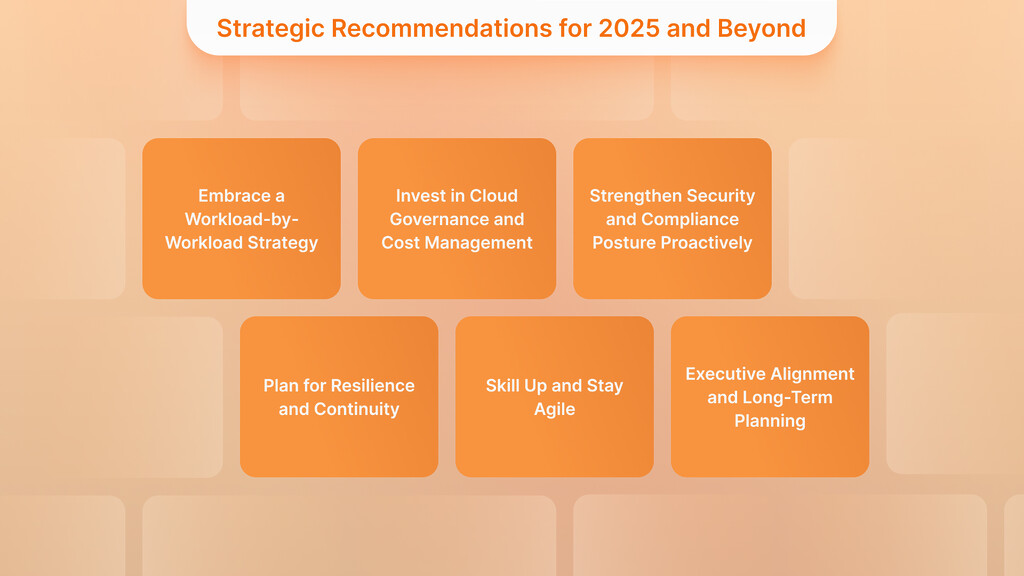
By 2025, the dilemma of cloud or on-premise infrastructure is not about determining a one-size-fits-all solution, but creating the right combination for your organization’s needs. As the above analysis shows, the two models possess strongly appealing pros and cons, at least in terms of the dimension under discussion. As a matter of fact, a thoughtful hybrid approach with the advantages of both methods is the best approach that many enterprises can rely on. The following are some of the practical tips and suggestions as you develop your infrastructure strategy:
Embrace a Workload-by-Workload Strategy
Assess each application or service on a case-by-case basis as opposed to an all-in cloud or on-prem only strategy. Take into account such aspects as sensitivity, variability of demand, and integration requirements. This bit-by-bit migration can tend to demonstrate that specific systems are ideally cloud (e.g., customer-facing, highly elastic services), and specific systems are best left on-prem (e.g., latency-critical or highly regulated data stores).
Invest in Cloud Governance and Cost Management
If you adopt cloud services, establish good FinOps practices and cost governance from the outset. Make use of budgeting instruments, establish cost alerts, and monitor the usage of resources to prevent the main trap of unexpected overruns.
Cost optimization of cloud is a continuous practice, like right-sizing instances and using reserved or spot instances to run consistent loads, which can save a lot of money. In the on-premises world, you should periodically re-evaluate your capacity and refresh rates to ensure you are neither over-provisioned (wasting capital by purchasing hardware you are not using) nor under-provisioned (which may result in performance issues).
Strengthen Security and Compliance Posture Proactively
Security and compliance should not be an afterthought, no matter which infrastructure you pick. In case of relying on cloud, utilize the security services of the provider; however, also provide your own level of encryption, access control, and surveillance. Make sure cloud setups are according to best practices (so as not to be misconfigured and cause a breach).
When using on-premises solutions, you should perform periodic security checks and ensure that systems are patched and kept up to date. Keep compliance records in order, in the cloud, which may involve gathering vendor certificates and demonstrating that your configuration is up to standard; in an on-premises environment, it means conducting internal audits and possibly external ones as well. Notably, enlist the services of your compliance and risk officers early in the planning process to make sure that the selected infrastructure meets regulatory expectations.
Plan for Resilience and Continuity
Have a sound disaster recovery and backup strategy that spans cloud and on-premises resources. Use the cloud as your only DR strategy or augment your on-prem primary with the cloud in some way, such as by backing up the on-prem data to cloud storage or utilizing cloud failover with your critical applications, even when your primary resides on-prem.
In contrast, when your key systems are cloud-based, you can consider maintaining backups in another cloud or on-premises to mitigate the outages of the provider. Test your failover and recovery procedures on a regular basis. An objective is to make sure that one mistake (crash of servers, network outage, or failure of cloud region) does not freeze your operations. This can be a combination of technologies, but the technologies of 2025 (starting with multi-region cloud deployments, all the way to on-prem high availability clusters) can make it a reality.
Web Development for a Strong Digital Foundation
Build a Robust Online Platform with Our Expertise
Discover Web DevelopmentSkill Up and Stay Agile
The fact that technology is rapidly evolving implies that you must be able to keep your team’s skills up to date and adapt quickly to your strategy. Training and certifications should be encouraged when using cloud architecture, and likewise, your IT personnel should be highly trained on modern technologies of virtualization, automation, and security on-premises.
A flexible workforce enables you to switch gears when necessary, such as when a new regulation creates a compelling reason to use on-premises solutions, or when a breakthrough cloud service could make you more competitive. In such cases, you can make a switch. Watch out for newer trends, such as edge computing, serverless architectures, and industry-specific clouds, which are likely to continue blurring the existing distinctions between cloud and on-premises solutions, but also potentially yield new optimization opportunities.
Executive Alignment and Long-Term Planning
Lastly, consider infrastructure decisions as a business strategy rather than an IT decision. Involve finance, compliance, operations, and product stakeholders in the discussion. Make an unambiguous plan that may have a staged migration or hybrid integration strategy.
As an example, you could choose: “In the coming 12 months, migrate our development and test environments to the cloud to achieve faster performance, whilst upgrading our on-prem core systems to improve performance; in 24 months, roll out a hybrid data lake such that sensitive data remains on prem but federated with cloud analytics”, etc. It is not an exaggeration to say that with this roadmap and executive buy-in, your cloud vs. on-premises decisions are aligned to the strategic objectives of the company (be it rapid innovation, cost leadership, better customer experience, or all of the above).
To conclude, cloud and on-premise are not mutually exclusive tools in the modern IT landscape. The winners will be the organizations that know how to intelligently and selectively apply the right tool to the task, utilizing the agility and abundant services of the cloud when appropriate, and retaining on-premise control where necessary, to comply with regulations, optimize costs, or perform more effectively.
Monitoring current trends and closely analyzing your own needs will allow you to develop a strategy of infrastructure that is resilient, compliant, and ready to innovate in 2025 and beyond. The ultimate aim is to make your business run efficiently, securely, and at optimized cost; whether it’s cloud, on-premises, or a perfectly orchestrated combination of the two.
Build Today, Scale Tomorrow: Selecting the Correct Infrastructure to Scale:
There are no longer black and white lines between cloud and on-prem. The thoughtful leaders of IT in 2025 adopt a strategy that transforms in line with the business requirements. The benefits of cloud infrastructure are speed, innovation, and cost efficiency, whereas on-premises solutions provide control and compliance.
A cloud-first strategy that involves on-premises augmentation when needed is the most resilient route for most organizations. It is hybrid, contemporary, and development-friendly, as well as scalable.
In search of modernization of your infrastructure? Contact our experts to design scalable, secure software that aligns with your long-term strategy.
Key Takeaways
- Cloud entails elasticity, cost-effectiveness, and low barriers to entry.
- On-premise has control, customization of security, and localization of data.
- OpEx versus CapEx has an impact on both short-term and long-term budgetary allocation.
- Cloud offers better performance in terms of scalability, disaster recovery, and agile development.
- On-premises deployments can still be justified on compliance needs.
- A combination strategy is usually the most balanced one.
Sources: The insights and statistics in this article are backed by industry research and reports, including Gartner forecasts, PwC’s 2023 Cloud Survey, Flexera’s State of the Cloud, and sector-specific studies. Notable references include CloudZero’s 2025 cloud spending snapshot, Red Hat’s guidance on cloud vs. on-prem repatriation, and case studies from Intersog, among others, as cited throughout. These provide a factual foundation for the comparisons and recommendations presented.
What is the difference between cloud and on-premise infrastructure?
The cloud infrastructure is provided by a third-party provider (such as AWS, Azure, GCP), is hosted and operated through the internet, and is flexible and scalable. On-premises infrastructure is deployed on-site and retains control with your organization, but it requires significant capital and in-house IT team support.
Cloud vs. On-Premise Cost: Which Is Cheaper in 2025?
Cloud has a low initial fee and a pay-as-you-go (OpEx). Nevertheless, 60 percent of businesses record amounts above anticipated invoices due to resource idleness and ineffective tracking. On-premise is CapEx-intensive and can be more predictable over the long term. On-Premise can be cheaper in terms of TCO for steady workloads.
What hidden costs come with cloud infrastructure?
Flexera estimates that 21% of cloud expenditures are idle/underutilized. Other costs not explicitly stated include egress fees, over-provisioning, and incorrectly configured services. FinOps practices help address these risks.
When is on-premise infrastructure more cost-effective?
On-premises is economical when workloads are predictable, high, and constant. Hardware is purchased once and can be used for several years, unlike variable monthly cloud payments. On-Premise may be more appropriate than apps that are forced by compliance and legacy systems.
Cloud vs. On-Premise Performance: Which Offers Lower Latency?
On-Premise infrastructure can provide ultra-low latency for real-time applications such as trading platforms or factory-floor operations. Cloud providers reduce latency with CDNs and edge computing, which are subject to unpredictable network conditions.
Is cloud infrastructure secure for sensitive data?
Organizations claim that 94% of security improves once they switch to the cloud; however, 68% of cloud breaches are attributed to misconfigurations. Cloud security is a joint responsibility model. On-Premises means total control; however, it requires security teams and ongoing updates.
Which industries still prefer on-premise infrastructure in 2025?
Sensitive workloads in highly regulated industries, such as finance, healthcare, insurance, defense, and others, remain on-prem. Nevertheless, most are using hybrid cloud strategies to address regulatory compliance while leveraging cloud scalability.
What is a hybrid cloud strategy, and why is it popular?
The hybrid approach combines cloud and on-premises systems, enabling flexibility, compliance, and performance. Large enterprises (over 56%) are deploying hybrid environments to manage cloud spikes while maintaining control over core on-prem operations.
How does cloud infrastructure handle compliance (HIPAA, GDPR, PCI)?
The large cloud providers also present region-specific services and new certifications such as HIPAA, SOC 2, and GDPR compliance. Nevertheless, enterprises need to set up services in a reasonable manner to prevent breaches. Zero-trust compliance models or air-gapped compliance models are used on-prem.
Cloud vs. On-Premise Backup and Disaster Recovery: Which Is Better?
Cloud providers provide embedded geo-replication, automatic backups, and rapid failover. On-prem, on the other hand, involves dedicated DR sites and is more expensive and difficult to operate. Most mid-sized and large businesses are now using cloud-first disaster recovery.
How can companies avoid vendor lock-in with cloud providers?
Vendor lock-in occurs when you are tied to a vendor’s proprietary services. Containerization (e.g., Kubernetes), cloud-neutral tools, and multi-cloud strategies are used to reduce companies’ risk. This increases portability and bargaining.
Can you scale on-prem infrastructure as easily as cloud?
Not really. Resources can be scaled within minutes on cloud platforms. On-prem requires hardware purchases, installation, and additional staffing. Cloud is unprecedented in scalability for situations where rapid expansion is needed or unpredictable loads are required.
How do companies manage cloud costs effectively in 2025?
The best practices include FinOps, cost notifications, compute optimization, instance reservation, and idle resource management. Spend control is also provided by cloud providers in real time through dashboards and analytics.
What’s the best infrastructure choice for my workload?
Do a workload-by-workload analysis. Latency-sensitive, regulated, or legacy applications could still be left on-prem. Cloud applications would be scalable, customer-facing, or bursty. The hybrid models have become popular in many organizations to align workloads with the best environments.
How should IT leaders choose between cloud, on-premise, or hybrid in 2025?
Take into account budget, compliance requirements, latency requirements, team capabilities, and current infrastructure. When presented with a choice, a hybrid model usually prevails — it provides control over sensitive systems and dexterity in innovation. It depends on strategic alignment and not on cloud-only.
